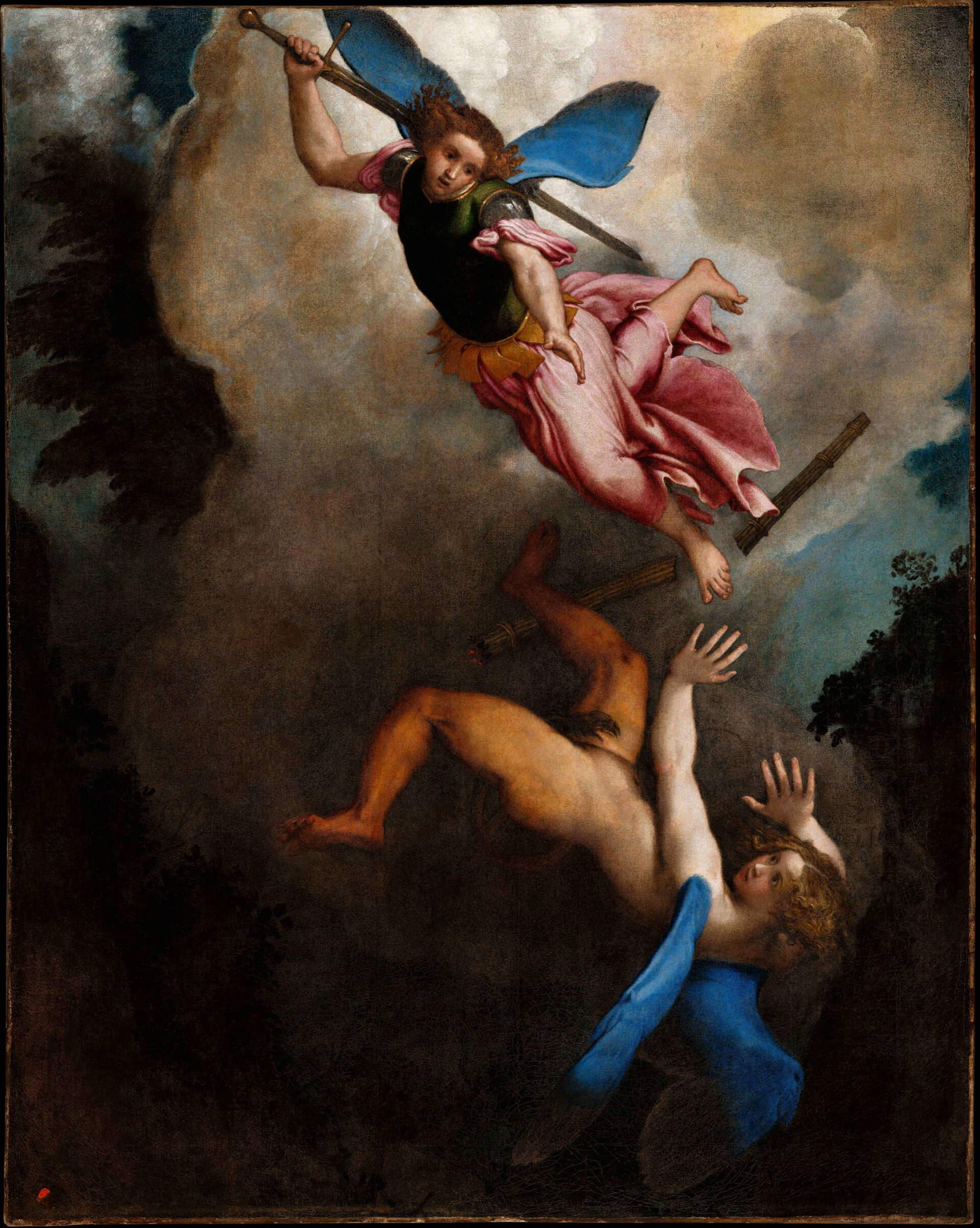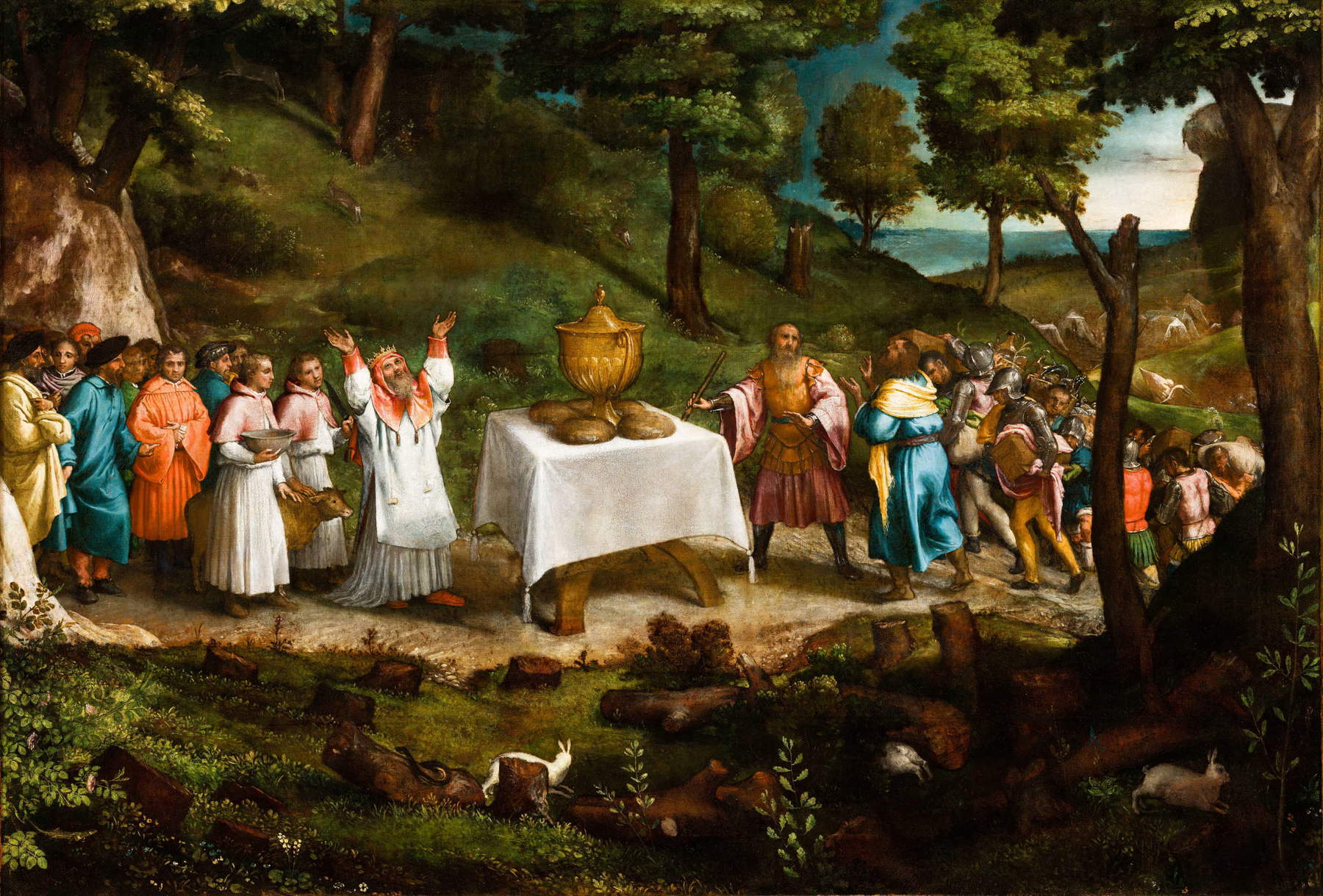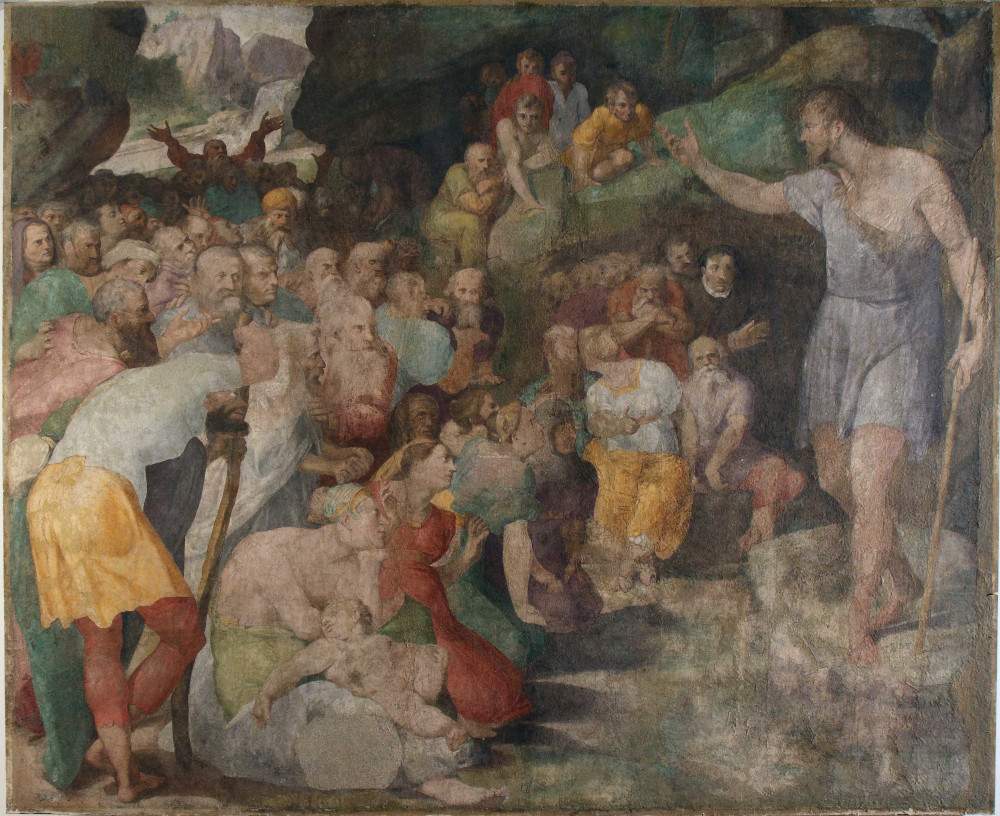Lorenzo Lotto and those anti-heretical paintings that perhaps inspired Pellegrino Tibaldi
A snow-white and almost lunar arm attempts to grasp a hand beneath him: it is thearchangel Michael, shrouded in the divine glow of a cloud, seemingly in a last desperate and vain attempt to save the brazen morning star, still in human and harmonious features, now decaying. Lorenzo Lotto’s altarpiece, dated between 1545 and 1550, depicts precisely St. Michael the Archangel with his torso clasped in a breastplate, imprisoning a crimson-red robe beneath as he chases, uncertain, Lucifer into the darkness. “But they overcame him by the blood of the Lamb,” the text ofRevelation (12:7) reminds us, “and by the testimony of their martyrdom; for they despised life unto death. Rejoice, therefore, O heavens, and you who dwell in them. But woe to you, land and sea, for the devil has rushed upon you full of great fury, knowing that he has little time left.” Many attempted, throughout their mortal lives, to describe the fall of Lucifer, but none painted him with the powerful and graceful humanity of Lorenzo Lotto in his great work St. Michael Hunt Lucifer.
Of course, surely our minds can quickly lead us to the memory of Alexandre Cabanel’s The Fallen Angel of 1847, or again to Guillaume Geefs with his Genius of Evil of 1848, but it was certainly the Venetian painter, born in 1480, among the first to restore a human and ephebic face to that fallen angel who so resembles and frightens us. It was in the Book of Miscellaneous Expenses that Lotto said he had delivered in September 1542, for the church of San Lio in Venice, an “altarpiece de un San Michele cobatere et caciare Luciffero,” while in 1545 he purchased in Treviso “un telar per l’altro san Michiel,” what in all likelihood became the painting on display, after restoration, at the exhibition Lorenzo Lotto e Pellegrino Tibaldi. Masterpieces from the Holy House of Loreto (through March 17, 2024). The work, referred to by Lotto himself as “el quadro de Lucifero,” was exhibited in 1550 at the Loggia dei Mercanti in Ancona, but remained sadly unsold. Without losing heart, then, he decided to take it with him along with other works to Loreto and make a gift of it to the Shrine of the Holy House in conjunction with his act of oblation on September 8, 1554.

We do not yet know, with extreme precision, every stay of the artist, but what is certain is that he was a wanderer. Growing up in the Venetian context, he looked to the masters of the time such as Alvise Vivarini and Giovanni Bellini, taking from one the other’s attention to detail and chromatic richness: all blended vividly in the perfect harmony of the young artist’s palette. From his Bergamasque sojourns, however, Lotto inherited the immense creative fervor and a deep sensitivity to human depiction that was always represented in his works with elegance and extreme grace. Each of his brushstrokes seems to be guided by the psychology of the character who reveals, through color, physiognomic features, but above all every hope, fear and emotion capturing the full range of human experience.
We are accustomed today to thinking that Lorenzo Lotto was a lonely and mistreated artist since history has counted him among the losers, the defeated and the eternal seconds. “According to the vulgate,” says Pontifical Museum Santa Casa di Loreto director Vito Punzi, “the choice to end his long wanderings as an artist as an oblate of the Shrine of the Holy House would have been the inevitable outcome of his long life as a loser. In reality then Loreto was anything but.” And in fact it would be the Shrine of the Holy House that would mark what was one of the most significant chapters of his existence. The shrine, from the last decades of the 15th century, became a building site where the popes wanted to realize grandiose works calling the most esteemed architects, painters and sculptors including Bramante, Luca Signorelli, Melozzo da Forlì, Giuliano da Maiano, Giuliano da Sangallo, Pellegrino Tibaldi and others. Lorenzo Lotto arrived definitively at “Santa Maria de Loreto” bringing, as he himself wrote, “tute mie robe, per habitar” and, above all, bringing with him a good number of paintings that had remained unsold, in the hope of giving them a worthy placement. The artist happily succeeded when Governor Gaspare Dotti asked him to create some works for the Chapel of the Choir of the church of Santa Maria, and the Venetian artist succeeded, thus, in adjusting the measurements of five of his works, brought from Ancona, to which he added only two paintings that he made the last years of his life.
Among the artists with whom Lotto intersected was certainly the younger Pellegrino Tibaldi. A knot, that between the two painters, which before the retrospective in Cuneo, little or nothing was investigated, but the meeting between the two turns out to be not only plausible: the influence seems to be palpable. When Tibaldi, not yet in his thirties, arrived in Loreto, the Venetian artist, now over seventy, ill in the eyes, and perhaps voiceless, was making the last works for the choir cycle with the Adoration of the Magi and the Presentation in the Temple. And precisely because of the presence of both in the same period, scholar Teresa Pugliatti first hypothesized how “Tibaldi’s Lauretan paintings see a strong influence of the Lottesque brush manifesting the use of a looser line” and “of a more personal and less titanic Michelangeloism than in his earlier works.” The young Valsodan Tibaldi, however, not only refined technique, but seems to have taken consistent inspiration from the elder artist for the episode narrating the preaching of St. John. “Observe,” says art historian Francesca Coltrinari, “especially the figure that stands out against the light in the distance, with his arms spread wide, emerging from the indistinct crowd of dramatically confused and simplified faces. To him in particular seems to be addressed the Baptist’s gesture of call: it is that gesture that lifts him, he, the last and distant, from the darkness and casts him against the light of the mountain, where the opposition light/darkness takes on a clear symbolic meaning of the opposition between sin and redemption.”
The hypothesis advanced seems to suggest that in a distant figure from Tibaldi’s Sermon of the Baptist, the 1545 Lotto Melchizedek can be identified as the one who welcomed and blessed Abraham and was invited by the Baptist to recognize him as “father.” Lotto, at the time, was recognized as the “painter of the Holy House,” and that designation, as Coltrinari points out, will remain unique in the history of the place. It will not now seem absurd to fantasize and think how Tibaldi may have sought inspiration, silently learning from the elderly master to bring his frescoes to life.
Thanks to the payments recorded in some documents kept in the sanctuary’s Historical Archives, we can state with absolute certainty that the frescoes depicting the Baptist, heavily ruined by time, were created by Pellegrino Tibaldi between 1553 and 1555.
Giorgio Vasari, in the second edition of his 1568 Vite de più eccellenti pittori, scultori ed architetti, provided a detailed description of the frescoes: in the vault, within a rich score of stuccoes, were the depiction of the Nativity and the Presentation of Christ in the Temple with Simeon, in the center the transfigured Savior on Mount Tabor, accompanied by Moses, Elijah and the disciples, while above the altar Tibaldi painted St. John the Baptist baptizing Christ, with Cardinal Ottone Truchsess (commissioner of the work) portrayed kneeling. On the facades, on one side he painted Saint John preaching to the crowds, while on the other side he depicted the saint’s beheading, and below the church, Tibaldi fleshed out the stories of the Judgment, using some figures in chiaroscuro to make the scenes more vivid and engaging. In the Sermon of the Baptist, the saint speaks emphatically to a packed and interested crowd, which comes closer and closer to hear him at his best, while in the background stands out the figure of the man so much like Melchizedek: the priest-king of the Old Testament.
It is therefore particularly intriguing to see the use of the same formula in two works placed within the same context. A pathetic formula that sees two figures with arms raised and overbearingly wide open expressing violent emotion.
That of Melchizedek is an episode from the Genesis account (14:17-19), in which the priest of Salem offered bread, wine and a sacrificial lamb to Abraham and his troops, and the man, in gratitude, returned the blessing by giving him the tenth part of the spoils of war. Lorenzo Lotto’s composition, adapted for the choir of the Canons of Loreto in 1552, follows a scheme already used by the artist, with a central altar and two groups of figures facing each other on either side. Prominent in the scene are Abraham, indicated by the staff of command, Melchizedek followed by a procession of priests dressed in the style of the 16th century, and four loaves and a bronze amphora on the white table that symbolize the Eucharistic offering and identify Melchizedek with the Messiah.


In the tense period of the Counter-Reformation, the Shrine of the Holy House of Loreto was under Cardinal Rodolfo Pio da Carpi, and Lotto’s work seems to suggest a reading of Melchizedek as the perfect priest, without ancestry, lineage or dynasty and therefore eternal, as eternal is the priesthood of Christ and therefore readable in an anti-Jewish and anti-heretical key. There were many restorations and one of them, the one in 2011, revealed Lorenzo Lotto’s signature on the broken trunk in the foreground.
Even more recent was the restoration of the work with Saint Michael the Archangel hunting Lucifer entrusted to Alberto Sangalli, who played a significant role not only in removing a piece of fascina-torch added by a hand not in keeping with the original artistic style, but also in restoring the freshness and brilliance of the colors typical of Venetian painting. In addition to the tail, the restoration made it possible to rediscover a second monstrous element: the black claws sprouting from the toes that were previously invisible.
The various studies conducted have even discovered how the sword, raised behind St. Michael’s back, was nothing more than an afterthought of the artist who originally placed it in front of the archangel’s torso, thus catching him in the act of breaking the faggot-torch of the eternal fallen one. This retracing of his steps and repositioning of the weapon, depicting a scene just before, allowed Lorenzo Lotto to charge the scene with a poignant emotionality in which the saint seems to engage in an extreme gesture of charity by trying to draw Lucifer to himself. But he, falling, as if to perform denial, attempts the last desperate act of pride and insubordination to the one who made himself a messenger of God’s will. An extremely interesting interpretation, suggested by Francesca Coltrinari, is inspired by the heretics depicted upside down in the Suardi Oratory in Trescore and could consider Lucifer’s exile as a metaphor for the Catholic Church’s struggle against Protestants. This is perhaps the ideological nexus that links St. Michael the Archangel to the Melchizedek Sacrifice.
In the combat of Michael the Archangel against Lucifer, it is possible to admire the wings of the two protagonists in an otherworldly and evanescent blue that grasp and capture every gaze, while only later will one notice a Lucifer with still angelic features except for the demon-like tail and the sharp, black toenails that are visible almost sharply precisely because of the precious and recent restoration. It is a Satan, Lotto’s, caught in the infinite act of falling. A Satan who has not yet fallen, but is falling toward thathell that is considered by many religions to be a place of perdition, absolute despair and punishment, where the most wicked souls are destined to serve tremendous punishments for eternity. A fallen angel who is not yet that common devil with monstrous features, but is simply the morning star who had the audacity to defy God.
Lucifer, arrogantly convinced of his plan, does in fact challenge the divine, losing, and Lotto seems to rabdomantically foretell the path that writer John Milton took in 1667 with his Paradise Lost: “Wretched me! by what gateway can I ever escape infinite wrath, and infinite despair? For wherever I escape it is always hell: I am hell; and in the deepest abyss another still deeper abyss opens wide, and threatens to devour me, and in comparison the hell I suffer seems to me to be a heaven.”
Standing before this magniloquent shovel one might have the feeling that it might be talking about us since the mistake made by Satan is the same one we make every day wandering in this world as we try to make irrelevant the uncertainties, insecurities, and sufferings that hold our hands every day. As we try to erase the existence of failure and impending death. And as always, at the reckoning, we fall before that granitic certainty that we will always remain ourselves, naked before life and naked before death. For in the end, at the personal reckoning, that dark abyss into which we will fall we will have painted with our own hands.
Warning: the translation into English of the original Italian article was created using automatic tools. We undertake to review all articles, but we do not guarantee the total absence of inaccuracies in the translation due to the program. You can find the original by clicking on the ITA button. If you find any mistake,please contact us.





























